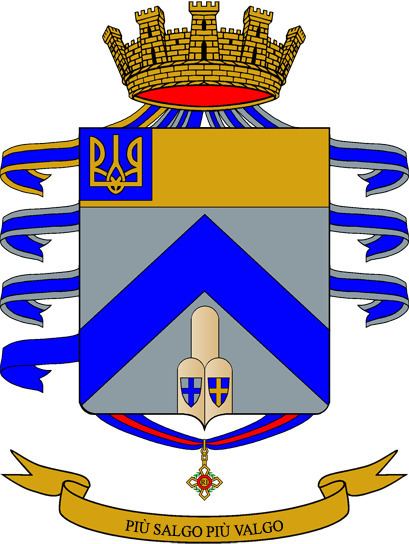Country Italy | Role Mountain Infantry | |
 | ||
Active 1 Nov. 1882 - 10 Sept. 194316 April 1946 - 30 September 197515 January 1993 - today Size 1 BattalionBassano Battalion | ||
The 6th Alpini Regiment (Italian: 6° Reggimento Alpini) is a light Infantry regiment of the Italian Army, specializing in Mountain warfare. The Alpini are a mountain infantry corps of the Italian Army, that distinguished itself in combat during World War I and World War II.
Contents
Formation
The 6th Alpini Regiment was formed on November 1, 1882. It consisted of the three battalions: Val d'Orco, Val d'Aosta, Val Tagliamento, named after the valleys and localities from which their soldiers were recruited. In 1886 two new battalions were raised and the now five battalions were renamed, taking their new names from the location of their main logistic depot: Verona, Vicenza, Bassano, Pieve di Cadore and Gemona. The latter two battalions passed to the newly formed 7th Alpini Regiment on August 1, 1887.
World War I
The 6th regiment saw its first action in the Italo-Turkish War 1911, fighting Ottoman forces in the Libyan desert. During World War I the regiment consisted of 10 battalions and saw heavy fighting in the Alps against Austria’s Kaiserjäger and Germany’s Alpenkorps. The battalions of the regiment in these days were (pre-war raised units in bold, followed by their first and second line reserve battalions):
Interwar Period
On September 10, 1935 the 2nd Alpine Division “Tridentina” was formed and composed of the 5th Alpini and 6th Alpini Regiments and the 2nd Mountain Artillery Regiment. In 1937 the battalions are reorganized and renamed: Vestone, Verona and Trento. The "Trento" battalion was placed under command of the newly formed 11th Alpini Regiment and participated in the Second Italo-Abyssinian War.
World War II
On June 21, 1940 (one day before the French surrender) the “Tridentina” division began to advance with other Italian units into Southern France. The division was then sent to Albania, where it sustained heavy losses in the Italian attack on Greece. As the German Wehrmacht came to the aid of the beaten Italian armies in Albania in April 1941 through the invasion of Yugoslavia the “Tridentina” was sent repatriated for rest and refit.
In September 1942 the “Tridentina” under the command of General Luigi Reverberi was sent together with the Alpini divisions Julia and Cuneense and other Italian units to the Soviet Union to form the ARMIR (Armata Italiana in Russia or Italian Army in Russia) and fight alongside the Germans against the Red Army. The 6th regiment was augmented by the Val Chiese battalion before leaving Italy. Taking up positions along the Don River the Italian units covered part of the left flank of the German Sixth Army, which spearheaded the German summer offensive of 1942 into the city of Stalingrad.
After successfully encircling the German Sixth army in Stalingrad the Red Army’s attention turned to the Italian units along the Don. On January 14, 1943 the Soviet offensive Operation Little Saturn began and the three Alpini division found themselves quickly encircled by the rapidly advancing armoured Soviet Forces. After 12 days of heavy fighting the Julia and Cuneense divisions were completely annihilated. The remnants of the Tridentina were able to break the Soviet encirclement in the epic and desperate Battle of Nikolayevka on January 26, 1943 allowing the 4250 survivors (out of 15000 troops deployed) to reach German lines.
The few survivors of the 6th Regiment were repatriated and after the signing of the Italian armistice with the Allies on September 8, 1943 the regiment was dissolved on September 10, 1943 in the Italian village of Fortezza.
The Cold War
After World War II the 6th Alpini regiment was reformed on April 16, 1946 in the city of Meran with the battalions "Edolo", "Bolzano" and "Trento" and became the sole Alpini regiment of the reformed Alpine Brigade Tridentina. In 1951 the reformed "Bassano" battalion returned to the 6th Alpini and on January 1, 1953 it ceded the "Edolo" battalion to the reformed 5th Alpini Regiment. On September 30, 1975 the regiment was disbanded and its battalions came under direct command of the Tridentina Brigade. The regimental colours and traditions were given to the care of the "Bassano" battalion.
Today
On January 15, 1993 the 6th Alpini Regiment was reformed and the "Bassano" became its single battalion. Today the 6th Regiment consists of the “Bassano” battalion, the regimental command and a logistic support company. The regiment is based in Innichen in South Tyrol and directly subordinated to the Alpine Troops Command (COMALP). It functions as a NATO-wide high altitude warfare training centre and administers the Training Areas in the Puster Valley.
